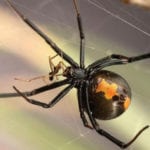 History
History  History
History  Technology
Technology Top 10 Everyday Tech Buzzwords That Hide a Darker Past
 Humans
Humans 10 Everyday Human Behaviors That Are Actually Survival Instincts
 Animals
Animals 10 Animals That Humiliated and Harmed Historical Leaders
 History
History 10 Most Influential Protests in Modern History
 Creepy
Creepy 10 More Representations of Death from Myth, Legend, and Folktale
 Technology
Technology 10 Scientific Breakthroughs of 2025 That’ll Change Everything
 Our World
Our World 10 Ways Icelandic Culture Makes Other Countries Look Boring
 Misconceptions
Misconceptions 10 Common Misconceptions About the Victorian Era
 Mysteries
Mysteries 10 Strange Unexplained Mysteries of 2025
 History
History 10 Things You Didn’t Know About the American National Anthem
 Technology
Technology Top 10 Everyday Tech Buzzwords That Hide a Darker Past
 Humans
Humans 10 Everyday Human Behaviors That Are Actually Survival Instincts
Who's Behind Listverse?

Jamie Frater
Head Editor
Jamie founded Listverse due to an insatiable desire to share fascinating, obscure, and bizarre facts. He has been a guest speaker on numerous national radio and television stations and is a five time published author.
More About Us Animals
Animals 10 Animals That Humiliated and Harmed Historical Leaders
 History
History 10 Most Influential Protests in Modern History
 Creepy
Creepy 10 More Representations of Death from Myth, Legend, and Folktale
 Technology
Technology 10 Scientific Breakthroughs of 2025 That’ll Change Everything
 Our World
Our World 10 Ways Icelandic Culture Makes Other Countries Look Boring
 Misconceptions
Misconceptions 10 Common Misconceptions About the Victorian Era
 Mysteries
Mysteries 10 Strange Unexplained Mysteries of 2025
10 Disgusting Animal Habits That Will Make Your Skin Crawl
Animals and bugs have a lot of creepy habits. Most of them are harmless, some of them are weird, and just a few are so mind-bendingly freaky and upsetting that they make you itch just thinking about them. For example, consider that . . .
10 Tarantulas Migrate In Herds Of Thousands
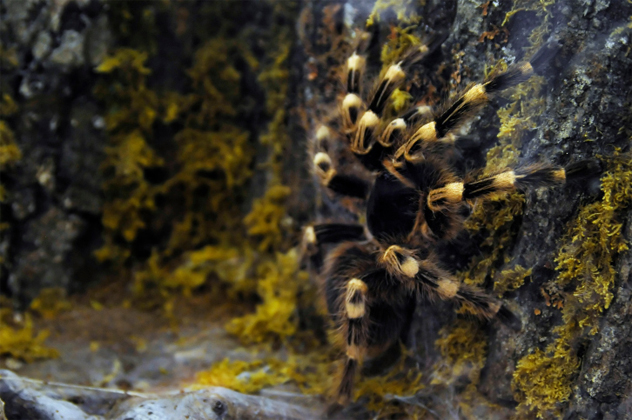
Of all of the animals you’d expect to travel in packs, tarantulas are probably at the bottom of the list, right next to goldfish and unopened boxes of animal crackers. But they totally do.
Every year, in places like southern California, thousands of male tarantulas will leave their burrows in autumn to seek out a mate. The tarantulas will ignore their usual stealthy tactics in search of their new mate and will not hesitate to straight-up invade a person’s home if it’s in the way. It’s supposedly not uncommon to see dozens of giant tarantula spiders crawling across the floor behind you, right now. The phenomenon is so common that every year, animal control will receive dozens of calls from terrified home owners finding the eight-legged monstrosities in their houses.
Don’t worry though, because according to experts, technically this doesn’t count as a “migration;” it’s just a group of several thousand of the world’s largest spiders all moving in the same direction as your house. Which is much less terrifying, right?
9 Vampire Bats Will Target The Same Victim Every Night
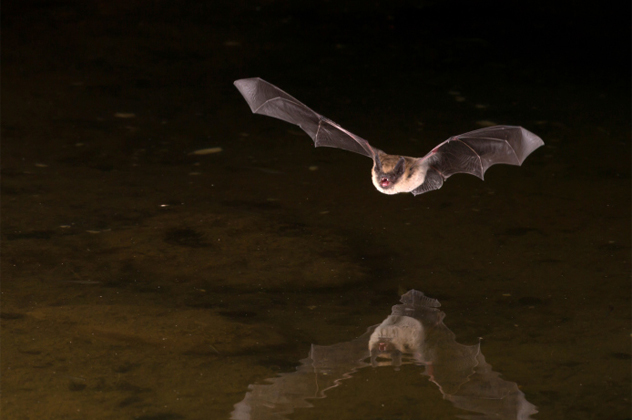
As far as blood-sucking animals go, you could be bitten by worse things than a vampire bat. Along with being a decidedly fuzzy creature, the vampire bat is a remarkably disease-free animal, meaning your risk of catching rabies or anything else from a bite is very unlikely. They also only hunt at night and have teeth so sharp that their bite is virtually painless.
However, they do have one rather unsavory habit that is probably going to make you hate them forever—for reasons scientists aren’t quite sure of, vampire bats tend to feed on the same victim night after night. To make it worse, scientists have discovered that the common vampire bat is able to recognize an individual human being solely by the sound they make when they’re breathing.
That means that if you’re ever bitten by a bat and it happens to think you’re pretty tasty, it will not only seek you out to feed from you again, but it will also remember the exact sound of your breath, like a tiny winged ex-girlfriend.
8 Fire Ants Always Bite At The Same Time
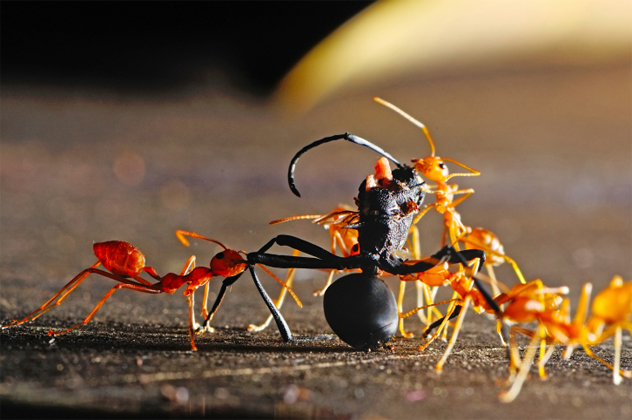
Fun fact: The fire ant was named that because its sting is not unlike being set on fire. They can also sting multiple times while biting you. That on its own would be scary enough, but fire ants have another trick up their tiny ant sleeves: psychic powers.
When fire ants attack, they rarely bite straight away; instead, they will almost always wait for a few seconds to synchronize the bites of the entire army. It isn’t clear exactly how fire ants are able to do this. One theory is that the ants sting in response to a reaction movement, such as a person recoiling in horror at the sight of hundreds of ants crawling up their arm.
Whatever the reason, by doing this fire ants are able to make their stings exponentially more painful. By attacking all at the same time, they’re able to ensure that the victim isn’t aware they’re being attacked until they’re being attacked by hundreds of ants at once. In other words, if you ever step on a fire ant nest, you won’t know it until most of the ants are already staking out a piece of your skin for a shock-and-awe campaign against your leg.
7 The Brown Tree Snake Attacks Sleeping Babies
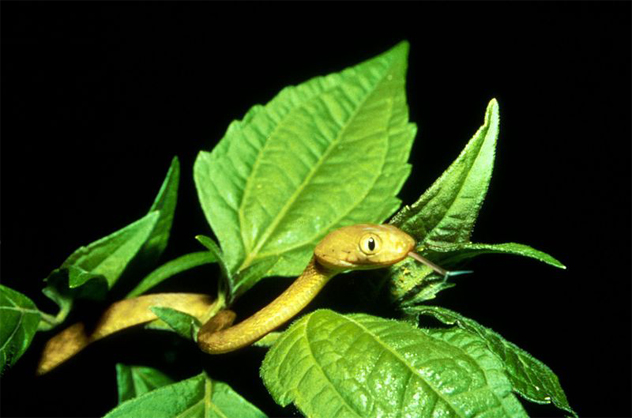
The brown tree snake is an invasive species of snake that was accidentally introduced to the island of Guam sometime during World War II. Though the snake is known for being largely harmless to humans, it has caused considerable problems for people living on the island over the last 60 years.
For starters, the snake is so abundant that power lines have been brought down under the sheer weight of the reptiles lying on them. If being hit on the head by three angry, falling snakes isn’t terrifying enough for the island’s residents, the brown tree snake has become infamous among locals due to its habit of attacking children and babies while they’re trying to sleep.
Scientists and researchers are genuinely baffled about why the snakes would do this, since sleeping people pose no threat to the snakes, and even the smallest, most delicious smelling baby is too large for a brown tree snake to possibly consume, ruling out the possibility of the snakes attacking these people to feed or out of aggression. All of which has left scientists with no reasonable explanation as to why the snakes would go to the effort of sneaking into a baby’s room just to bite a passive victim.
As if that wasn’t creepy enough, experiments have shown that the snakes are attracted to the smell of menstrual blood and that they will actively seek it out. The researchers weren’t able to tell whether it was the menstrual blood specifically that the snakes wanted, or if they were just sniffing around for human blood in general, but really, would either answer make you feel safer? And in case you’re wondering, the experiment was carried out exactly like you might imagine—by dangling tampons in front of hungry snakes.
6 The Hairy Frog Breaks Its Own Bones In Defense
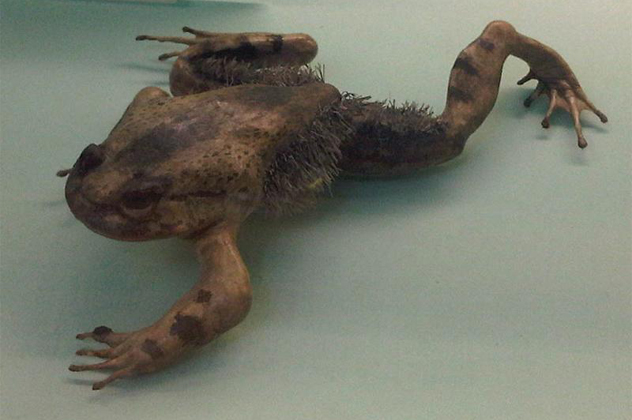
The hairy frog, sometimes known by its stage name of Trichobatrachus robustus, is a small amphibian with perhaps the single most disgusting method of defending itself in the entire animal kingdom.
When threatened, the hairy frog will produce a small pair of tiny bone claws that erupt from the ends of its toes. These claws are normally stored inside the frog’s own body, and the only way for it to actually unsheathe involves physically breaking them and forcing them through its own skin.
Imagine for a second breaking your own fingers and then trying to force the jagged pieces of bone through your palms; that’s essentially what the hairy frog does every single time it’s attacked. As of yet, no one is really sure if the frog has the ability to retract its claws after it has pushed them through its own skin.
If that wasn’t disgusting enough, during mating season the frog will also grow long strands of “hair-like” pieces of skin and arteries along the side of its body to help it take in more oxygen, so along with having Wolverine claws, they also have Wolverine sideburns.
5 Tasmanian Devils Are Born Scarred
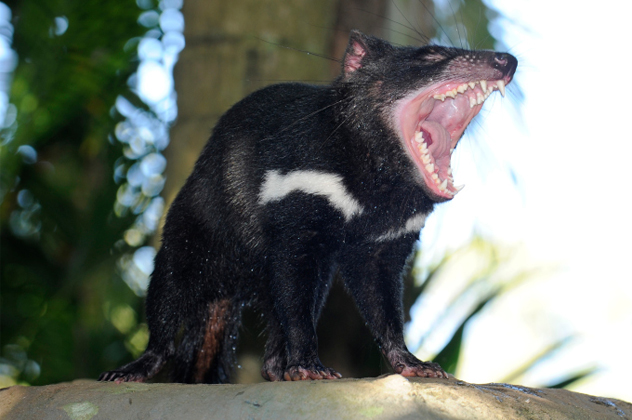
Like their cartoon counterpart, Tasmanian devils are vicious, loud, and dangerous. They’re also one of the few creatures on Earth that is born fighting. You see, a mommy Tasmanian devil will usually give birth to about 30–50 pups; however, she only has four teats from which the pups can feed.
You don’t have to be a math genius to realize that something is wrong with that equation, and you don’t need to be a biologist to guess what happens next. The instant they’re born, the pups will begin to fight for access to a teat. They will bite, scratch, and try to kill their own brothers and sister eight seconds after being born. As the Tasmanian devil is a marsupial, this all happens inside of the mother’s pouch, which is said to writhe and squeal as this is happening.
Very few newborn pups survive this ordeal, and it’s extremely rare for more than a handful to survive. It’s noted that the fighting among pups is so fierce that some will even leave their mother’s pouch covered in wounds, scars, and the blood of their dead siblings. That’s just hardcore.
4 The Horse Bot Fly Lays Its Eggs In A Horse’s Tongue
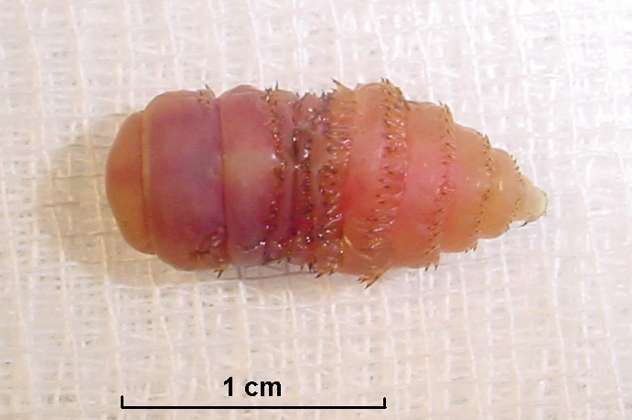
Bot flies are a group of bugs that lay their eggs inside the flesh of living beings. Though Dermatobia hominis (the bot fly that lays its eggs inside of a human) is the member of this family that gets the most press, its cousin, Gasterophilus intestinalis (the common horse bot fly), should be the one that makes your skin crawl, even if it doesn’t lay its eggs beneath your skin.
The common horse bot fly is so named because it lays its eggs on the hair of horses, donkeys, and other equids. As the animal grooms itself these eggs will hatch and the larvae will either enter the animal’s stomach or burrow into its tongue, gums, or mouth lining to grow.
After they’ve matured for a few days, the larvae will then make their way to the equid’s stomach, where they will then attach themselves to the lining of the animal’s intestines with about a hundred of their friends, and wait nine months to be pooped out. Oh, and just in case you were wondering, yes, these things can also infect humans. However, they’re unable to live inside of us and will die after a few days—after they’ve burrowed their way into your lips, of course.
3 Komodo Dragons Swallow Prey Whole
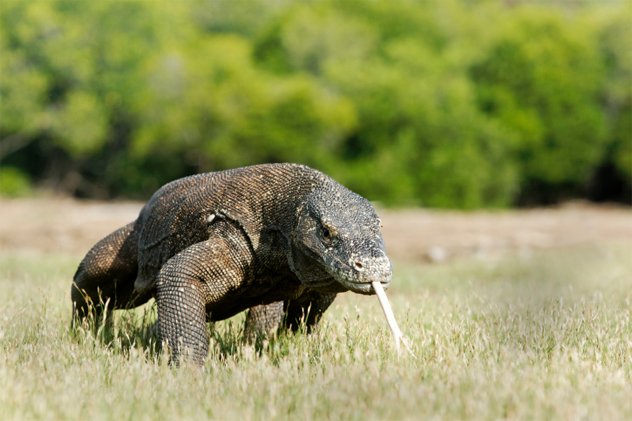
Though they’re powerful and stealthy hunters, capable of stalking prey for many miles before ending their life in a single, crushing blow, komodo dragons will throw all of that out of the window the second they begin eating.
Komodo dragons will go to extreme lengths to make sure that they’re full, and they have been observed in the wild running headlong into trees to force the food down their gullets and break the bones of whatever it is they’re currently trying to digest. The force with which komodo dragons do this has been known to uproot small trees.
If the image of a giant lizard forcing half a goat down its own throat by crushing it against a tree isn’t already unsettling enough, komodo dragons have also been known to raid recently dug graves for food. This problem is so widespread that it is common practice on Komodo Island to cover the graves of the recently deceased with large, heavy rocks to dissuade the dragons from digging them back up.
Locals on the island are so terrified of the creatures and their eating habits that houses on the island are built on stilts so that the creatures can’t enter their homes.
2 Mosquitoes Can Smell Your Blood
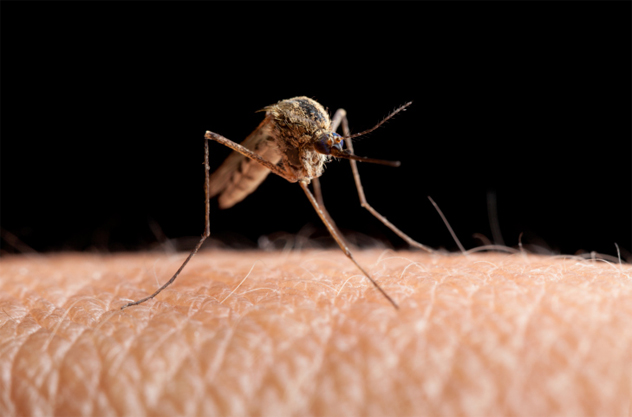
In a 2004 study conducted in Japan, it was discovered that mosquitoes will instinctively target people with type O blood far more than they will target other people. Along with meaning that about 45 percent of the people reading this have a tiny bull’s-eye on their veins, it also means that mosquitoes can literally smell your blood.
To make it worse, a mosquito will intentionally seek out the people it deems more attractive, while actively ignoring the ones it doesn’t. For example, in the Japanese study mentioned above, mosquitoes ignored dozens of other people in the same room in favor of repeatedly trying to bite the same few, unlucky individuals.
Basically, if you have type O blood, even if you’re surrounded by friends, a mosquito is going to know exactly where you are, and it’s going to go out of its way to bite you regardless of how many people are in the way.
1 There’s A Type Of Bee That Drinks Your Tears
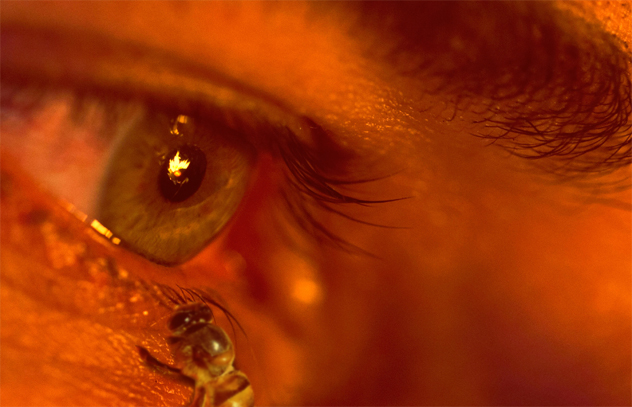
None of that title is hyperbole—there is literally a species of bee that can gain sustenance from your tears. Though the bees will normally be happy to feed on your sweat, they can and will opt instead to drink your tears if the opportunity presents itself.
If that wasn’t bad enough, as researchers in Thailand noted, when presented with the chance to feed from a person’s eyes, it took dozens of failed attempts before the bee would lose interest and try to find food elsewhere. Perhaps the worst part of all of this is the fact that the bees themselves are so adept at feeding this way that, most of the time, the people they’re feeding from don’t even notice. You could actually have bees feeding from your eyes right now.
Karl has a Twitter account, if you’re into that sort of thing.






